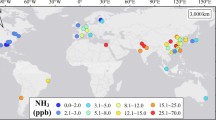Atmospheric ammonia is emerging increasingly as the key transboundary air pollutant that will contribute to future impacts of nitrogen and acidity on terrestrial ecosystems in Europe. At the same time, ammonia is making an increasing relative contribution to particulate matter, with its associated human health risks. These features are shown clearly in Fig. 1.1 below, from the Clean Air For Europe (CAFE) programme.
Thus, by 2020, it is estimated that NH3 will be the largest single contributor to each of acidification, eutrophication and secondary particulate matter in Europe. This increase is particularly a reflection of the success of European policies to reduce SO2 and NOx emissions. As a result, NH3 is increasingly dominating nitrogen and acidifying inputs, while reducing ammonia emissions and the associated environmental impacts remain major challenges for the future.
Access this chapter
Tax calculation will be finalised at checkout
Purchases are for personal use only
Preview
Unable to display preview. Download preview PDF.
Similar content being viewed by others
References
Aas W. (2005) Workshop on the implementation of the EMEP monitoring strategy (Ed.) (Oslo, 22–24 November 2004). EMEP Co-operative Programme for Monitoring and Evaluation of the Long-Range Transmission of Air Pollutants in Europe, EMEP/CCC 2-2005. NILU, Kjeller, Norway. (http://www.nilu.no/projects/ccc/reports/cccr2-2005.pdf)
Achermann B. and Bobbink R. (2003) Empirical Critical Loads for Nitrogen (UNECE Expert Work-shop, Berne 11–13 November 2002) (Eds.) pp 327. SAEFL, Berne, Switzerland.
Ashmore M.R. and Wilson R.B. (eds.) (1994) Critical levels of air pollutants for Europe. Report of the UNECE Expert Workshop at Egham, UK (23–26 March 1992). Department of the Environment, London.
Bobbink R., Ashmore M., Braun S., Flückiger W., and Van den Wyngaert I.J.J. (2003) Empirical nitrogen critical loads for natural and semi-natural ecosystems: 2002 update. In: Achermann B. and Bobbink R. (eds.) Empirical Critical Loads for Nitrogen (UNECE Expert Workshop, Berne 11–13 November 2002) pp 43–170. SAEFL, Berne, Switzerland. (http://www.iap.ch/ publikationen/nworkshop-background.pdf)
Erisman J.W., Bleeker A., and van Jaarsveld J.A. (1998) Evaluation of the effectiveness of the ammonia policy using measurements and model results. Environmental Pollution 102, 269–274.
Horvath L. and Sutton M.A. (1998) Long term record of ammonia and ammonium concentrations at K-puszta, Hungary. Atmospheric Environment (Ammonia Special Issue) 32, 339–344.
ICP Modelling and Map** (2004) Manual on Methodologies and Criteria for Map** Critical Levels/Loads and Geographical Areas Where They Are Exceeded. UBA-Texte 52/04. (http:// www.oekodata.com/icpmap**/index.html)
Lövblad G. and Sutton M.A. (1997) The requirements for monitoring data for the assessment of transboundary air pollution effects to man and ecosystems. In: J. Schaug and K. Uhse (eds.) EMEP/WMO Workshop on Strategies for Monitoring of Regional Air Pollution in Relation to the Need Within EMEP, GAW and Other International Bodies (Aspenaas Herrgaard, Sweden 2–4 June 1997) pp 83–119. EMEP/CCC Report 10/97. NILU, Kjeller, Norway.
Menzi H. and Achermann B. (2001) UNECE Ammonia Expert Group (Berne 18–20 September 2000) Proceedings (Eds.) 157 Swiss Agency for Environment, Forest and Landscape (SAEFL), Bern (Copy of Working Group 2 report). (http://www.nitroeurope.eu/ammonia_ws/documents/ AEG_bern_wg2_report.pdf)
Posthumus A.C. (1988) Critical levels for effects of NH3 and NH4+. In UNECE (1988) Proceedings of the Bad Harzburg Workshop, pp 117–127. UBA, Berlin.
Sutton M.A., Asman W.A.H., and Schjørring J.K. (1993) Dry deposition of reduced nitrogen. In: Lövblad G., Erisman J.W. and Fowler D. (eds.) Models and Methods for the Quantification of Atmospheric Input to Ecosystems, pp 125–143. Nordiske Seminarog Arbejdsrapporter 1993:573. Nordic Council of Ministers, Copenhagen (revised version published in: Tellus (1994) 46B, 255–273).
Sutton M.A., Asman W.A.H., Ellerman T., van Jaarsveld J.A., Acker K., Aneja V., Duyzer J.H., Horvath L., Paramonov S., Mitosinkova M., Tang Y.S. Achermann B., Gauger T., Bartnicki J., Neftel A., and Erisman J.W. (2001) Establishing the link between ammonia emission control and measurements of reduced nitrogen concentrations and deposition. In: Menzi H. and Achermann B.(eds.) UNECE Ammonia Expert Group (Berne 18–20 September 2000) Proceedings, pp 57–84. Swiss Agency for Environment, Forest and Landscape (SAEFL), Bern (revised version published in: Environmental Monitoring and Assessment (2003) 82: 149–185).
Sutton M.A., Cape J.N., Rihm B., Sheppard L.J., Smith R.I., Spranger T., and Fowler D. (2003) The importance of accurate background atmospheric deposition estimates in setting critical loads for nitrogen. In: B. Achermann and R. Bobbink (eds.) Empirical Critical Loads for Nitrogen (UNECE Expert Workshop, Berne 11–13 November 2002) pp 231–257. SAEFL, Berne, Switzerland.
UNECE (2007) Review of the 1999 Gothenburg Protocol. Report on the Workshop on Atmospheric Ammonia: Detecting Emission Changes and Environmental Impacts. Report to the 39th Session of the Working Group on Strategies and Review. ECE/EB.AIR/WG.5/2007/3. (http:// www.unece.org/env/lrtap/WorkingGroups/wgs/docs39th%20session.htm)
van der Eerden L.J., Dueck T.A., Berdowski J.J.M, Greven H., and van Dobben H.F. (1991) Influence of NH3 and (NH4)2SO4 on heathland vegetation. Acta Botanica Neerlandica 40 (4), 281–296.
van der Eerden L.J., Dueck T.A., Posthumus A.C., and Tonneijck A.E.G. (1994) Assessment of critical levels for air pollution effects on vegetation: some considerations and a case study on NH3. In: Ashmore M.R. and Wilsons R.B. (eds.) Critical Levels of Air Pollutants for Europe, pp 55–63. Department of Environment, London.
van Jaarsveld J.A., Bleeker A., and Hoogervorst N.J.P. (2000) Evaluatie ammoniak emissieredukties met behulp van metigen en modelberekeningen. RIVM report 722108025. RIVM, Bilthoven, The Netherlands (in Dutch).
Editor information
Editors and Affiliations
Rights and permissions
Copyright information
© 2009 Springer Science + Business Media B.V.
About this chapter
Cite this chapter
Sutton, M.A. (2009). Introduction. In: Sutton, M.A., Reis, S., Baker, S.M. (eds) Atmospheric Ammonia. Springer, Dordrecht. https://doi.org/10.1007/978-1-4020-9121-6_1
Download citation
DOI: https://doi.org/10.1007/978-1-4020-9121-6_1
Publisher Name: Springer, Dordrecht
Print ISBN: 978-1-4020-9120-9
Online ISBN: 978-1-4020-9121-6
eBook Packages: Earth and Environmental ScienceEarth and Environmental Science (R0)




